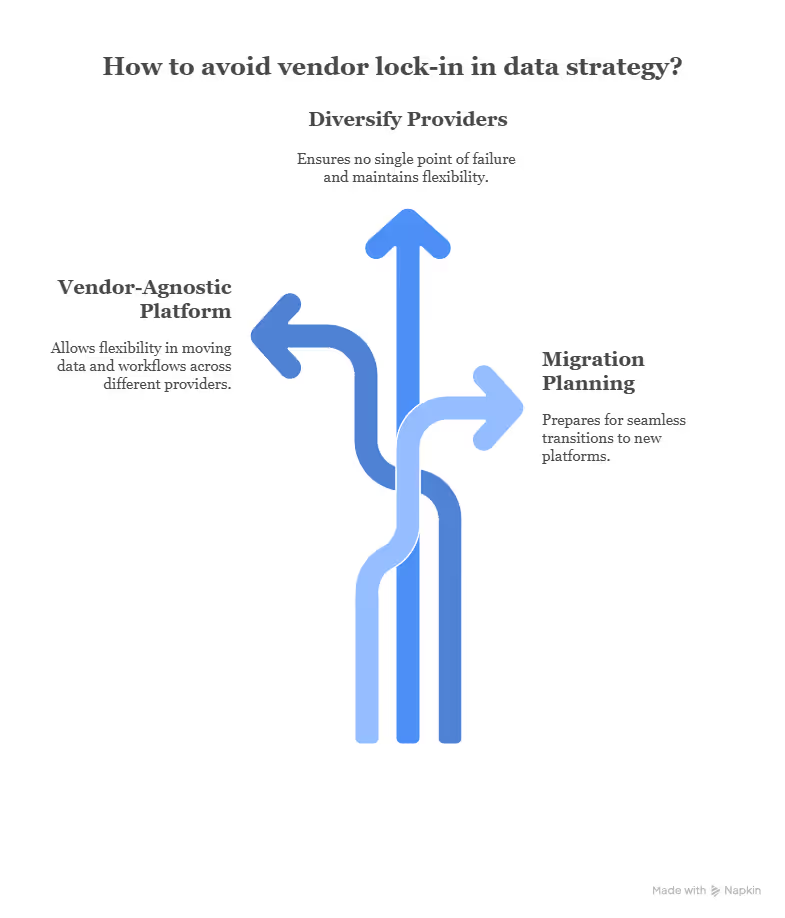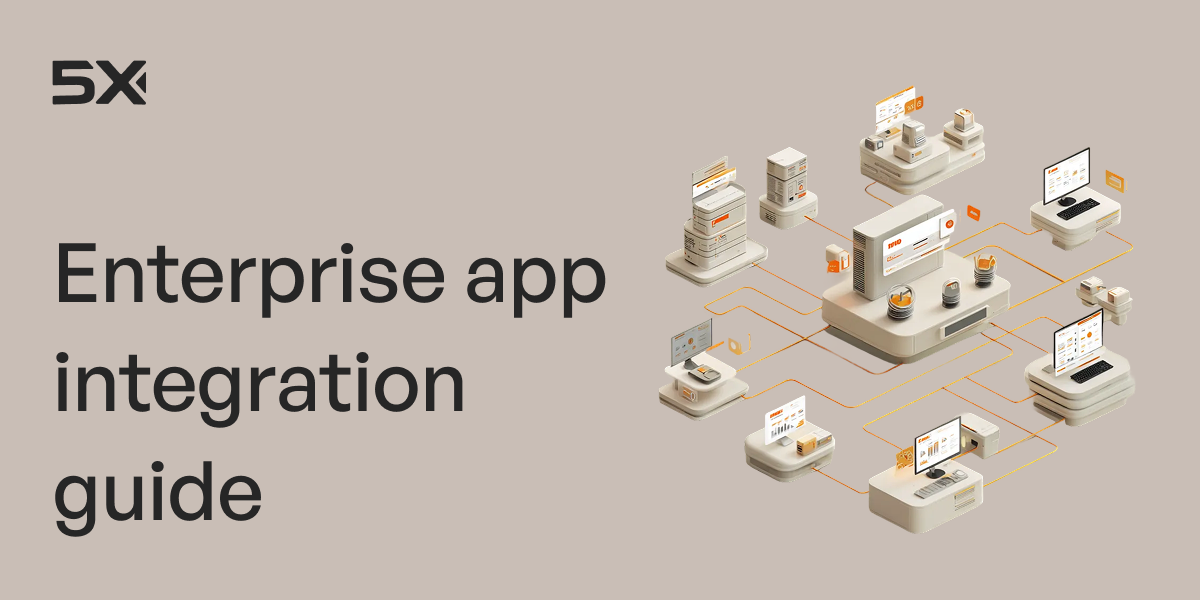Six common vendor lock-in traps In data platforms and how to avoid them


Table of Contents
TL; DR
Vendor lock-in makes it hard—and expensive—to switch data platforms.
Here are the six biggest traps to watch out for:
- Forced data migration before you can even use the tool
- Code rewrite lock with proprietary SDKs or languages
- Custom terms and workflows that don’t transfer
- Legal and pricing tricks like auto-renewals and tiered fees
- Closed ecosystems that block integrations
- Locked-in compute with no control over scaling or cost
To avoid lock-in:
- Choose open, vendor-agnostic tools
- Distribute services across platforms
- Always plan for easy migration—even if things seem fine now
If you feel trapped with a data analytics vendor who controls your tools, your data, and even your KPIs, you’re not alone. Vendor lock-in often means you’re tracking the metrics prioritized by your vendors, not necessarily the ones your business truly needs.
Vendor lock-in sounds harmless until you’re stuck paying more for less. Many vendors quietly make it difficult for you to leave their platform, resulting in rising costs and missed opportunities. In 2025’s fast-moving data world, that kind of vendor lock-in can kill your agility and.
Read this article to explore the biggest vendor lock-in traps and how to avoid them.
What is vendor lock-in in data platforms?
Ever felt stuck with a tech tool because switching just seems like way too much work (or money)?
That’s vendor lock-in. It’s when you become so tied to one product or service that leaving feels more painful than sticking around, even if another option could be better for your business.
Relying on one data platform for everything is like putting all your eggs in one basket and then handing that basket to someone who controls the price of eggs. You don’t want that. But it happens more often than you think because of restrictive contracts, pricey integrations, or just the sheer hassle of migrating to something new. Some vendors actually want it this way.
In the world of SaaS and subscription-based tools, the harder it is for you to leave, the longer your vendor keeps cashing on your checks. While that works for them, it’s not great for your business.
What’s the real cost of vendor lock-in?

Vendor lock-in isn’t just a mild inconvenience, it’s a handbrake on your business intelligence, your budget, and even your ability to innovate.
Beyond money, here’s what a vendor-lock actually costs you:
- Limited choice and flexibility: When you’re tied to one vendor’s ecosystem, you lose the freedom to explore better technology or competitive pricing elsewhere. Imagine knowing there’s a faster, cheaper, more scalable solution on the market, but your contract makes switching almost impossible. That means missed opportunities, slower adaptation to market changes, and storage infrastructure that can’t keep up with your business needs
- Increased costs: Once a vendor knows you can’t easily leave, your pricing power disappears. You might pay more upfront for hardware, face steep maintenance fees, and get boxed into overpriced upgrades. And if you want out, migrating can be so costly and complex that you’re forced to keep paying just to avoid the pain of moving
- Operational bottlenecks: Vendor-specific tools can turn your IT environment into a collection of walled gardens. Your team ends up juggling multiple siloed systems that don’t play nicely together, leading to inefficiencies, integration headaches, and compatibility issues that slow everything down. The more you adapt to their way of working, the harder it is to break free
- Reduced innovation: When vendors don’t have to compete for your business, they don’t feel the pressure to innovate. That means fewer upgrades, slower performance improvements, and missed breakthroughs in storage tech. Over time, you’re stuck on aging infrastructure, footing the bill for a solution that no longer works, while the market moves forward
Major vendor lock-in traps you should avoid in 2025:
In a fast-moving tech landscape, the last thing you want is to be stuck with a single data platform you can’t easily move away from, especially as vendors get acquired, change roadmaps, or hike prices.
The danger isn’t always obvious upfront. It starts with small “requirements” that sound reasonable, but before you know it, you’re deeply tied to a vendor’s infrastructure, code, and ecosystem. Suddenly, switching becomes a multi-month, high-cost nightmare.
Here’s where lock-in often hides, and how we tackle it head-on:
1. Data migration lock
Some vendors insist you migrate all your data into their storage before you can even start. Sounds harmless until you factor in the migration costs, time delays, and potential downtime. Suddenly, you’re trapped before you’ve even built a single pipeline.
Unsure of migration because you’re afraid of losing data in the process?
Read the guide
2. Code rewrite lock
Proprietary SDKs and languages might make a vendor’s product look sleek, but they’re also a clever way to keep you dependent. Once your team has rewritten code in their language, moving away becomes costly and painful. It’s like building your house with bricks that only one company manufactures. You can’t replace them without tearing everything down.
This trap also appears when vendors require custom integrations that don’t work with standard APIs, forcing you to use specialized query languages, or lock your workflows into their unique architecture.
3. Proprietary terms and patterns
Custom terminology and one-of-a-kind workflows might look innovative on a sales call, but they create knowledge silos and onboarding headaches. As a result, your team spends weeks learning vendor-specific lingo and processes that don’t transfer anywhere else. This not only slows onboarding for new hires but also makes switching vendors harder than it needs to be.
For example, that “FlowBuilder” the vendor hyped is just a basic workflow tool but it’s built in such a unique way that you need their training videos and documentation to even get started. Similarly, that “SmartTrigger” system automates workflows only inside their data platform. If you want to replicate it with another tool, you’ll have to re-map everything from scratch.
4. Legal and pricing traps
Multi-year contracts, minimum spend commitments, and sneaky overage fees are the oldest lock-in tricks in the book. But vendors have gotten creative.
Some vendors hide auto-renewals in the fine print so if you miss the cancellation date, you’re stuck for another year. Others bundle “essential” features into expensive tiers you never asked for. Some penalize you for leaving early, not just with fees, but by holding your data hostage until you pay up.
5. Locked ecosystem
A locked ecosystem is like buying a fancy coffee machine that only takes one brand’s pods and those pods cost a fortune. Some vendors do the same thing. They create a walled garden where only their tools, add-ons, or “approved” partners can integrate. On the surface, this can feel seamless (“everything just works!”), but over time it chips away at your flexibility.
Want to plug in your preferred analytics tool? Not supported.
Found a cheaper automation service? Sorry, no integration.
You’re left with two choices. Pay extra for the platform’s own feature (often less robust and more expensive) or go without. Both options are bad for your budget and your long-term agility.
6. Locked-in compute
Ever had a vendor say, “Oh, you can only run this on our cloud”?
Sounds harmless until you realize they’ve built a toll booth on your operations. Suddenly, you’re paying their rates, on their terms, with zero wiggle room.
Need more compute power for a seasonal spike? Sure, but at their premium prices.
Want to scale down to cut costs? Nope, still locked in.
Found a faster, cheaper provider? Too bad, your workloads are chained to their infrastructure.
When your workflows are tied to one vendor’s cloud, you’re not just paying for compute, you’re also paying for lost control. Negotiation with vendors often comes with “we’ll email you the new bill”. Before you know it, you’re budgeting around their costs, not your business requirements.
Strategies to avoid vendor lock-in

If you’ve ever been stuck with a vendor you’ve outgrown, you know it’s a costly, frustrating place to be. The good news is that you can avoid it entirely if you’re intentional from the start.
Here’s how you can build freedom into your data strategy.
- Choose a vendor-agnostic data orchestration platform: Don’t tie yourself to a single cloud provider’s tools. A truly agnostic data platform lets you move data and workflows wherever they make the most sense
- Diversify your providers: Spread your services across multiple compatible vendors. With the right orchestration tools, you can even stream telemetry data to multiple destinations at once, so you’re never locked into a single pipeline
- Plan for migrations even if you’re happy now: Keep a migration plan on standby, test your extraction and transformation pipelines so you know exactly how to move, and run periodic drills to confirm you can move to another platform without disruption
Break free from vendor lock-in with 5X
Most data platforms talk about “flexibility,” but in practice, they lock you into their proprietary formats, storage, and workflows. 5X is built on an open-source foundation that lets you own your stack forever. With 5X, there’s no tool sprawl and no hidden traps.
Your data stays in your own cloud, and you can run 5X anywhere with no forced migrations, no hidden contracts, and no walled gardens. You can plug in any tool you like, build in plain SQL or Python, and keep your workflows portable. We don’t tie you to proprietary SDKs or formats.
If you decide to change tools, your work and data moves with you with no need for costly rewrites or drawn-out migrations. With 5X, you’re free to scale, adapt, and choose the best technologies for your business intelligence, without worrying about being stuck with one vendor’s roadmap or pricing.
What is a data platform vendor lock-in?

What are the main types of vendor lock-in in data platforms?

How can I prevent vendor lock-in when choosing a data platform?

What should I look for in a vendor's exit terms?

Building a data platform doesn’t have to be hectic. Spending over four months and 20% dev time just to set up your data platform is ridiculous. Make 5X your data partner with faster setups, lower upfront costs, and 0% dev time. Let your data engineering team focus on actioning insights, not building infrastructure ;)
Book a free consultationHere are some next steps you can take:
- Want to see it in action? Request a free demo.
- Want more guidance on using Preset via 5X? Explore our Help Docs.
- Ready to consolidate your data pipeline? Chat with us now.
Get notified when a new article is released

How retail leaders unlock hidden profits and 10% margins
Retailers are sitting on untapped profit opportunities—through pricing, inventory, and procurement. Find out how to uncover these hidden gains in our free webinar.
Save your spot






%201.svg)


.png)






